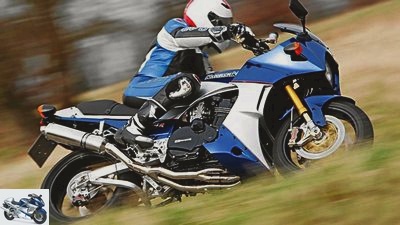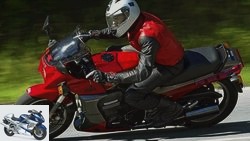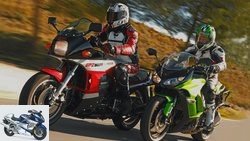Menus
- Built in the 80s, tuned in 2012
- A splendid chassis
- A four-cylinder to fall in love with
- Modification info

Jorg Kunstle, Klaus Dony
Kawasaki GPZ 900 R conversion from Bike Side
Built in the 80s, tuned in 2012
Content of
A motorcycle from the 80s with handling characteristics of the 21st century. The Company "Bike side" from Durmersheim has transformed a GPZ 900 R into a technical and optical masterpiece. The conversion shows what potential there is with appropriate investments in the engine and chassis of an 80s motorcycle.
The picture is still unforgettable today: When Kawasaki invited the world motorcycle press to a presentation in Laguna Seca in 1984, they had to GPZ 900 R master timed sprints over the quarter mile on the legendary US racetrack. We – 16 and 17 year olds at the time – burned themselves in with pictures of burnouts and smoking rear tires. Cool American dragster drivers wore tight leather and casual scarves. They created a myth. The first Kawasaki Ninja was a single steam announcement.
The 900 GPZ pointed to the future, for sale to everyone, equipped with just about everything that was possible in series production. Water cooling, two overhead camshafts, 16 valves, six-speed gearbox, air-assisted fork with AntiDive system. Open 115 hp, from 908 cc. The GPZ fell through the grid of all racing classes from the start. And at 257 kilograms it was a little heavy for racetracks. But the muscle man accelerated the fastest at the time, 3.6 seconds from zero to one hundred, 11.5 seconds for the sprint over the quarter mile.
All at once, the Honda CB 900 F Bol d’Or, which has been extremely successful since 1978, and the Yamaha XJ 900 F, which was only a year old, lost their sporty nimbus. Although the 100 HP self-restraint still applied in Germany, the first water-cooled GPZ (after the air-cooled sisters 750 Turbo and the 1100) had duped the competition with larger displacement. 241 kilometers per hour secured her the Blue Ribbon for the fastest production motorcycle.
Fascination to this day
All of that explains the story of this special GPZ 900 R, built in 1985, resurrected in 2012 – a milestone that continues to fascinate today. All the more if you invest around 28,000 euros in the youngtimer in order to spice it up with what is currently technically feasible. That was the order that the qualified engineer Klaus Dony received from the Bike Side company in Durmersheim, Baden. The customer from Austria didn’t just get his somewhat worn out 900s back on track. No, rather it required the balancing act of combining an icon of the 80s with driving characteristics of the 21st century. Cost what it may!
Only the characteristic shape, the silhouette and the appearance of the GPZ 900 R had to be retained. So the plastic parts including cladding were set from the start. The front and rear panels, side covers and tank were only thoroughly stripped and primed before fresh paint had to be applied. The tapered half-shell cladding to the left and right of the rectangular headlight looks like it always has, reminiscent of Darth Vader’s mask from “Star Wars". The true potential of this motorcycle is not revealed at a glance. Sympathetic understatement at the highest level.
A splendid chassis
Jorg Kunstle, Klaus Dony
The Schule elbows could shine as a work of art. Also noble: Ohlins shock absorber with new deflection and superbike swing arm.
“In the USA, such low-stacking motorcycles are called sleepers,” says Klaus Dony a little proudly. What he put on the wheels is the dream of an 80s motorcycle. Equipped with the best components and the finest custom-made products, trimmed for superb drivability. More is not possible!
The straight Superbike handlebars from ABM are perfect to hand. The bottom rests on the comfortable bench, which is individually padded for the needs of the owner. The knee angle is quite acute – the rigid footrests sit high on the beams milled from solid. Which is an advantage when driving and enables gigantic inclines.
But first get used to the motorcycle. From the start everything is easy, not at all traditional – clutch, brake, turn. The GPZ is inspired by moving light-footedness. Roundabouts are child’s play, fast waving is pure pleasure, the accuracy is terrific.
You feel at home in the very first corner. In the case of blind tasting, you’d guess a 600. Certainly not on a 900. And at most a 150 mm rear tire. The youngtimer rolls on a 190 / 55-17-inch model. Even current 1000s with 190 rear tires are hardly as handy as this Kawa. How can that be?
Well, Klaus Dony knows what he’s doing. He criticized the 80s Japanese across the board: “The chassis were too slack and the engines always lacked the right power.” He has basically eliminated both here. The chassis in particular appears to have been completely replaced.
The steel frame, now freshly powder-coated, and the screwed-on aluminum back remained in their original condition. Only the chassis geometry was radically on the collar, based on the key data of a Kawasaki ZRX 1100: wheelbase 1450 millimeters instead of the standard 1495, steering head angle 65 instead of 61 degrees, caster 104 instead of the lush 114 millimeters.
The measures to improve steering precision, handiness and feel for the front wheel were elaborate: Klaus Dony raised the rear by seven centimeters and thus placed a lot more load on the front wheel. However, this also resulted in problems. The Kruger company had to go twice & Junginger change the specially made swing arm, especially the stiffening girder, until everything fits. “The GPZ swing arm is difficult to set up due to its two-part bearing, which is individually guided to the left and right of the shock absorber,” explains Klaus. This resulted in space problems for new reversing levers. Ohlins has specially adapted the shock absorber to the new dimensions.
Jorg Kunstle, Klaus Dony
With the Bike side-GPZ 900 R, even a plain sprocket turns into a real feast for the eyes.
A narrow 520 DID racing chain of the type GRV 3 leaves space for the wide rear tire on the six-inch rim. The gold-colored, fully adjustable upside-down fork from Ohlins is of high quality. A new steering tube, a modified instrument mount and an adapted steering stop made it possible to install them. The fine Swedish goods are highly sensitive to the front and back. Comfortable for an athlete and yet tightly cushioned. This compromise was a great success.
Triple clamps with 20 millimeters less offset reduce caster. Lightweight PVM forged wheels, both 17 inches, reduce the rotating masses and thus the gyroscopic forces. According to Klaus Dony, the wider rims alone weigh up to five kilograms less than the standard wheels! The front wheel works wonders. The jitteriness of the 16-inch GPZ from 1984 to 1989 is forgotten. The Michelin Pilot Power harmonize perfectly, make the GPZ super-neutral and precise, and stick to the edge of the tire without any problems, even in cold temperatures.
A four-cylinder to fall in love with
Manufacturer
The Bike Side-Kawasaki GPZ 900 R: Conceived from idealism, built from experience,
Okay, wide tires require higher lean angles than narrow ones at the same speed. But it makes you feel faster. It’s nice to have the highest quality brakes on board: Brembo monoblocks bite hard and can be adjusted wonderfully. That’s a good thing, because this GPZ fires fresh wind in the form of around 130 hp. The tuned four-cylinder hangs fine on the gas, responds spontaneously to every twitch of the right wrist, is neatly tuned. Sixth gear in the lower rev range – no swallowing, no uneven running. This engine celebrates the grandeur and glory of an inline four-cylinder. An experience.
From 4500 rpm the breeze becomes stiffer, from 6000 tours the storm blows. Great. Should you complain that the vibrations also increase at the top? Or that the hydraulically operated clutch cannot be ideally dosed? Where does the power come from? The engine case and most of the engine internals remained original. Including crankshaft, clutch and gearbox. With the same stroke of 55 millimeters and an enlarged bore, the four-cylinder now has a capacity of 972 cm3. Mikuni flat slide carburetors of the type RS 36 prepare the mixture. On the outlet side there is an individually manufactured manifold system from the specialist Schule. An orgy in polished stainless steel.
The individual Cobra silencer sounds not very friendly to residents because it is quite rowdy. It sounds robust, ABE or not. Only the arms of the high pillion pegs that were welded to the rear frame made it possible to mount a four-in-one system. You alone save a whopping ten kilograms compared to the series. All in all, the Kawasaki should be lightened by around 17 to 240 kilograms. Good work.
Life would be a little poorer if you had never driven this skillfully refreshed Kawasaki. It’s one of the best ’80s street legal bikes. In any case, the most elaborately refined GPZ 900 R – one for real connoisseurs.

classic
Youngtimer test: Kawasaki GPZ 900 R
Strong then and now: Kawasaki GPZ 900 R
read more

Tourer
Generation comparison
27 years of Kawasaki sports tourers: GPZ 900 R and Z 1000 SX
read more
Modification info
Moderate tuning measures designed for stability bring around 130 hp peak power: 972 cm3 through more bore (75.0 instead of 72.5 millimeters), Wiseco pistons, compression increased from 11.0 to 11.7: 1, channels machined, camshafts "Stage 1" and Mikuni flat slide carburetors RS 36 with single K&N air filters. The latter were a real approval hurdle before the TÜV. Not to forget the Schule four-in-one manifold system with Cobra silencer.
The measures on the chassis were more extensive: The powder-coated steel frame with original rear made of aluminum takes a specially made Kruger&Junginger swing arm open. It is supported by a specially adapted Ohlins S46HR1C spring strut with an adapted deflection in order to raise the rear seven centimeters. Triple clamps with 20 millimeters less offset reduce caster. The specially adapted Ohlins upside-down fork FG43 impresses with its outstanding damping properties. Lightweight PVM forged wheels improve handling, modern 17-inch tires (Michelin Pilot Power) improve grip as well as stability and neutrality. Brembo monoblock four-piston calipers in the front wheel, milled from solid, decelerate impressively. The entire renovation, including painting, cost 28,000 euros. Of course, all components are also available individually from Bike Side.
| Kawasaki GPZ 900 R. | Bike Side-Kawasaki GPZ 900 R | |
| engine | Water-cooled four-cylinder four-stroke in-line engine, two overhead camshafts, four valves per cylinder, operated by fork rocker arms, Displacement 972 (908) cm³, bore x stroke 72.5 x 55 mm, Output approx. 74 kW (100 PS) at around 9500 rpm or 84.5 kW / 115 PS at 9500 rpm, Max. Torque approx. 85 Nm at 8500 rpm. |
Water-cooled four-cylinder four-stroke in-line engine,
two overhead camshafts,
four valves per cylinder, operated by fork rocker arms,
Displacement 972 (908) cm³, bore x stroke 75.0 x 55 mm,
Output approx. 96 kW (130 hp) at around 10,000 rpm,
Max. Torque approx. 90 Nm at 9000 rpm.
Power transmission
Multi-disc oil bath clutch, six-speed gearbox, chain drive.
Multi-disc oil bath clutch, six-speed gearbox, chain drive.
landing gear
Backbone frame made of tubular steel with screwed aluminum stern,
Telescopic fork, Ø 38 mm,
Two-arm swing arm made of aluminum profiles without a support,
Central spring strut, cast aluminum wheels,
Tires 120/80 V 16 at the front, 130/80 V 18 at the rear,
Double disc brake at the front, Ø 280 mm,
Single piston floating calipers,
Rear disc brake.
Backbone frame made of tubular steel with screwed aluminum stern,
Telescopic fork, Ø 50 mm,
Two-sided swing arm made of aluminum profiles with a support,
Central spring strut, forged aluminum wheels,
Tires 120/70 ZR 17 front, 190/55 ZR 17 rear,
Double disc brake at the front, Ø 320 mm,
Four-piston fixed calipers,
Rear disc brake.
Wheelbase 1495 mm,
Steering head angle 61 degrees,
Tank capacity 22.0 liters,
Weight with a full tank approx. 257 kg
Wheelbase 1450 mm,
Steering head angle 65 degrees,
Tank capacity 22.0 liters,
Weight with a full tank approx. 240 kg
Related articles
-
Presentation of Streetfighter conversions Bike Side-Honda X-Eleven and Dito Suzuki GSX 1300 R Hayabusa Wash, blow-dry, sweep A Honda X-Eleven and a …
-
Honda CB 1100 RS and Bike Side-Honda CB 1100 F in a comparison test
Arturo Rivas 34 photos Arturo Rivas 1/34 Honda CB 1100 RS and Bike Side-Honda CB 1100 F in comparison Arturo Rivas 2/34 Glossy: chrome-plated manifolds….
-
Suzuki GSR 750 premiere of the naked bike
Manufacturer Driving report: Suzuki GSR 750 New mid-range naked bike from Suzuki Content of The engine has been around for a long time and its potential…
-
Dream bike KTM 1290 Super Duke R
r-photography.info 29 pictures Jahn 1/29 Jahn 2/29 Impressive: the increase in torque at 6000 rpm. Jahn 3/29 Jahn 4/29 Mitterbauer 5/29 bevelled …
-
Kawasaki Z H2: Compressor naked bike with 200 hp
Innovations 2020 Top topic Luca Leicht 28 images Kawasaki 1/28 Kawasaki is bringing a hyper-naked bike with the Z H2. Kawasaki 2/28 premieres the Z H2 …
-
Jahn Master Bike 2007 Ten years of full throttle Since 1998 the Spanish colleagues of the magazine Motociclismo have been holding a racing party. And so many participants …
-
Emflux One electric sports bike from India
Photo: Emflux 12 pictures Emflux 1/12 With the Emflux One, a new electric motorcycle comes from India. It was presented in February 2018 at the Auto Expo …
-
Designbike Dodge Tomahawk Simply hatchet madness from Daimler-Chrysler: The auto company smashes the monotony of motorized boredom ?? with a…
-
Cult bike Yamaha FZR 1000 Exup
Hartmann cult bike Yamaha FZR 1000 Exup The big hit of 1989 Rarely has a motorcycle been improved so dramatically as the already great …
-
markus-jahn.com Cult bike Honda VF 1000 R Pioneer of the V4 concept In 1984 the Honda VF 1000 R was supposed to turn the world of super sports machines upside down ….